During a recent episode of The Best Defense TV show, my co-host and I demonstrated the use of a weapon strike against an opponent. I thought viewers might wonder why we would promote such a non-standard technique when simply shooting the person (if warranted) was possible.

A weapon strike is physically striking someone with a loaded, or in some cases unloaded, weapon with the intent of incapacitating or disrupting them in some way other than shooting them. In this article, I hope to demonstrate that weapon strikes are both effective and warranted in some cases. I’d like to create a broad understanding of the technique, including when it might be used, what level of force it would fall under, how to apply it, and some data on live-fire testing to see how strikes affect the functioning of various firearms. Does “muzzle punching” someone automatically knock the gun out of battery and make it inoperable?LegalitiesThis is a key concept in a situation where you might use a weapon strike against someone. The general rule is that if you access and point your loaded firearm at someone and strike him or her with it, the situation should be one where lethal force is legally justified. Pistol whipping someone into line is neither a realistic nor warranted use of force, considering the risk of the firearm going off and killing the person (or someone else in the area), even if you did not mean it to. Such a use of force, even accidentally, could likely be termed gross negligence and would be problematic in court.Using a weapon strike against someone attacking with a knife. While I would be justified in shooting the attacker, the bystander (represented by the dummy in the background) makes this hard to pull off during a fight.
The main thing to keep in mind is that your gun should never be used as a striking object unless you believe lethal force is legal and justified. If your gun is in your hand, and the person you are dealing with is still combative, it might be reasonable to assume (depending on the facts and circumstances) that if they continue to fight and get their hands on your gun, you could lose it and possibly be killed with it. For this reason, articulating lethal force in most cases should be relatively simple.
Reasons
In every class I teach, I focus on the “whys” behind what I am teaching. This is critical for students to fully understand any technique. Why would we use a weapon strike at all against someone if lethal force is justified? Why not just shoot them? The simple answer is that you probably can’t due to the dynamics of the situation. Maybe shooting and fighting have integrated to the point where you’re not 100% positive what is in front of your muzzle, e.g., your own body parts!

While sticking your rifle into someone’s chest may make it easier for him to grab, sometimes it is unavoidable. I know of numerous SWAT officers and members of military assault teams who have used non-lethal strikes against someone grabbing or reaching toward their muzzle. Shooting is sometimes not warranted, as in a case I heard about where a team entered the premises of a mentally unstable 80-year-old woman.

When striking someone with a rifle, it is possible to use the rifle in a very effective manner that does not require pointing the muzzle at the person. The military has long taught the “buttstroke” in varying angles as an effective rifle strike. But pay particular attention to where the muzzle ends up pointing in a situation like this (such as at your teammate).
Another problematic scenario is if you are with other people, such as your family or team members, when a fight occurs. What if one of your family members moves into the line of fire? I often have my wife and two kids with me. If we were violently attacked and I got a gun into the fight, one of the children may move into the line of fire during the chaos. If I am not 100% sure where my bullet will go, I will not pull the trigger. If I’m in a position where I can’t shoot, yet still have a gun in my hand, I have the choice of fighting with one hand and trying to protect the gun with the other, or possibly using the gun as a striking object. In more than one situation, I would pick the latter in an attempt to gain distance and/or have some sort of effect on the threat.
Those armed with a rifle may face the same situation, and might even find themselves more likely to use a firearm strike. I know of more than one SWAT officer who has used a muzzle bump into someone’s chest or face to convince him that reaching for his rifle muzzle might be a bad idea. A rifle offers a bigger need (and possibly reduced risk of an accidental shot) for the use of a weapon strike due to its length. It simply may not be an option to protect the rifle and strike the person with the other hand. Remember, if the bad guy is reaching for the muzzle, then in most circumstances this situation could warrant deadly force.
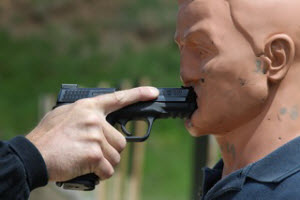
Finger position is out and completely away from the trigger guard or trigger. This prevents the finger slipping onto the trigger and discharging the weapon.

The trigger finger is dangerously close to the trigger guard and trigger. It may slip onto the trigger and discharge the weapon.
How ToIf a weapon strike is warranted and justified, how should we utilize it? First, stick to the principles in any combatives you may have already trained in, as they probably apply if you train in a good system. This may include:* Prioritize and strike target areas that have the most effect on the person. * Strike and retract the strike quickly to help prevent your gun being grabbed. * Utilize your non-gun hand as your lead strike. This will hopefully allow you to keep the gun back as much as possible. * Use movement to gain the advantage.When striking with the firearm, remember that we are striking at that specific moment because we do not want to shoot. So I recommend keeping your trigger finger out of the trigger guard and along the frame of either your handgun or rifle. This will ensure that the spontaneous reflex of gripping the gun during the strike will not cause it to discharge accidentally.Impact areas on the weapon include the muzzle (jabbing linear-type strike), bottom of the frame in front of the trigger guard (similar to a hammer fist), and top of the slide in a hooking motion (like a boxer’s hook). I do not recommend striking someone with the bottom of the magazine well with an automatic, due to the possibility of damaging the magazine and limiting your ability to shoot with the gun without doing a reload. With a rifle, we have additional striking surfaces that include the back and sides of the buttstock. The military has been teaching the “buttstroke” for many years, and it is an incredibly efficient tool against someone if shooting is not an option. The various strikes are illustrated below:
Jab Strike
Linear strike with the lead or rear hand, commonly known as a jab or cross.
Hammer Strike
The hammer fist strike is a downward blow with a closed fist.
Bottom of FrameWhen used with a handgun, the impact point is the frame of the gun under the barrel. I recommend not using the magazine area, to prevent breaking the base plate and causing more problems with the gun.
Hook Strike
The hook is a looping strike around the side of the head.
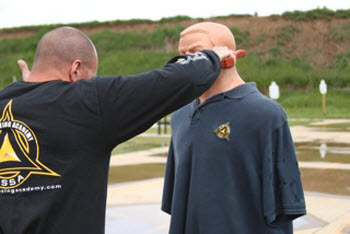
Top of SlideWhen done with a handgun in the hand, this strike is best done with the top of the slide.Live-Fire TestingWill using a firearm as a striking tool cause it to malfunction or break? There’s no way to find out other than testing it! I have a strike dummy shaped exactly like a human torso and tested these strikes with four different handguns to see if the firearms would sustain any damage or quit working due to a malfunction. The guns tested were a Smith & Wesson M&P 9, Glock 17, Springfield Armory XDM 4.5, and SIG Sauer P226. With each of the four handguns, I struck the dummy ten times with each of the three strikes I’ve recommended, but mainly focused on the jab (linear) strike, since it is most likely to put the weapon out of battery. After each strike, I fired one shot to see if the gun still worked.I tested four handguns to see if they would malfunction. None of them did. Left to Right: Springfield Armory XDM 4.5, Smith & Wesson M&P 9, SIG Sauer P226, Glock 17.
Safety note: This is a high-risk test. If you have not practiced weapon strikes, please do not repeat it.
Results

You can see by the movement of the shirt and dummy the amount of force I was hitting it with. I was trying to break something, or make the gun fail, with no luck!
The number under each gun is the number of times it failed to fire after the strike. To be as realistic as possible, each strike was thrown with as much power as I had.
As you can see, the strikes did not cause any of the weapons to malfunction. The only exception was when I tried to strike with the finger in the trigger guard while trying to shoot. The gun did not go off, so I count this as a malfunction. In that case I simply pulled the gun away from the strike dummy and the slide went right back into battery, allowing me to shoot. In a rare situation where the gun malfunctions completely, a simple “tap, rack” should clear and make it ready to fire. But as you can see from my results, all weapons fired flawlessly, without a single malfunction caused by the strikes.
Conclusions
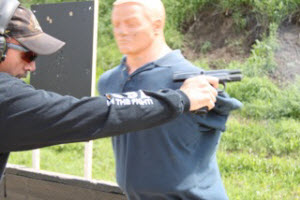
Directly after the strike, I fired the gun to see if it still functioned. They all did, every time. I did more than 70 strikes and never had a failure except once when I attempted to strike and shoot, and pushed the slide out of battery. This is a common occurrence and the reason we teach people not to push the muzzle into someone if they are trying to shoot.
In closing, weapon strikes are effective, simple, and great potential tools if needed in a close-quarters fight. Learning them is not difficult, and I recommend training them safely using non-firing red guns, S.I.R.T. pistols, or Airsoft before trying them during live-fire drills. Remember that striking someone with a weapon involves a high level of force, so make sure you have justification before doing it!
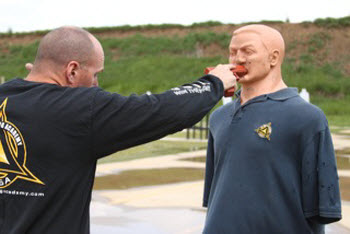

Good info. I have a red training gun I have a red plastic training gun I use for hitting practice on my heavy bag. Good. good ariticle!
[…] In this article, Mike Seeklander tried a variety of different pistol strikes against a “BOB” dummy and then attempted to fire rounds from the handgun he had used for the strikes. None of the strikes he used either broke the guns or caused them to malfunction. […]